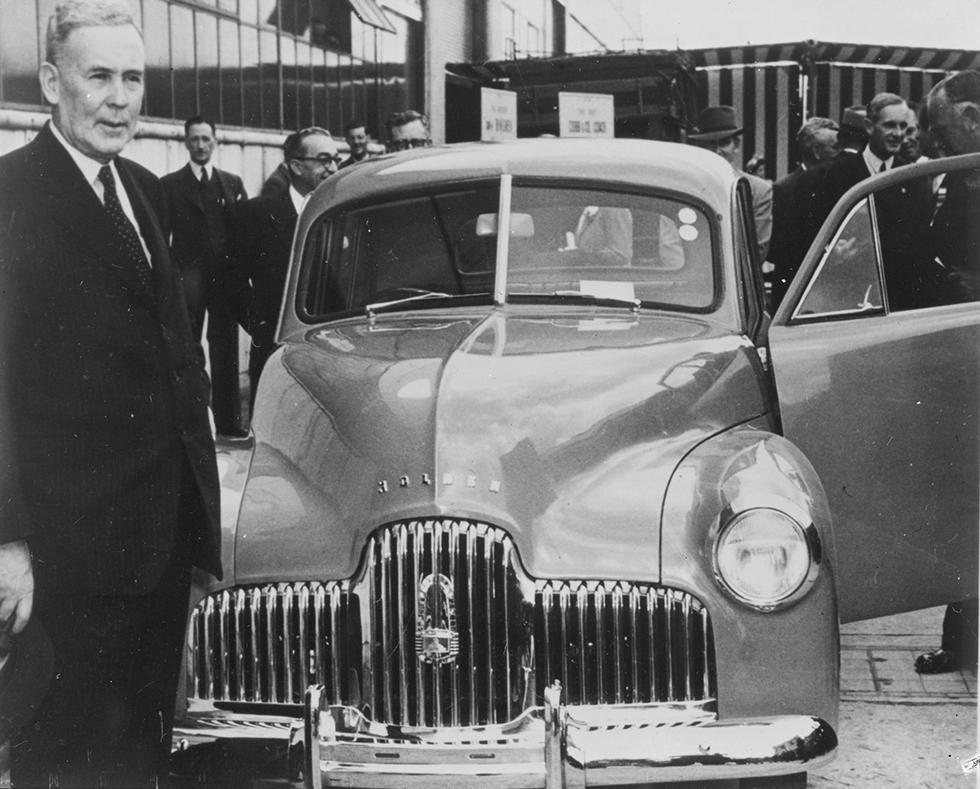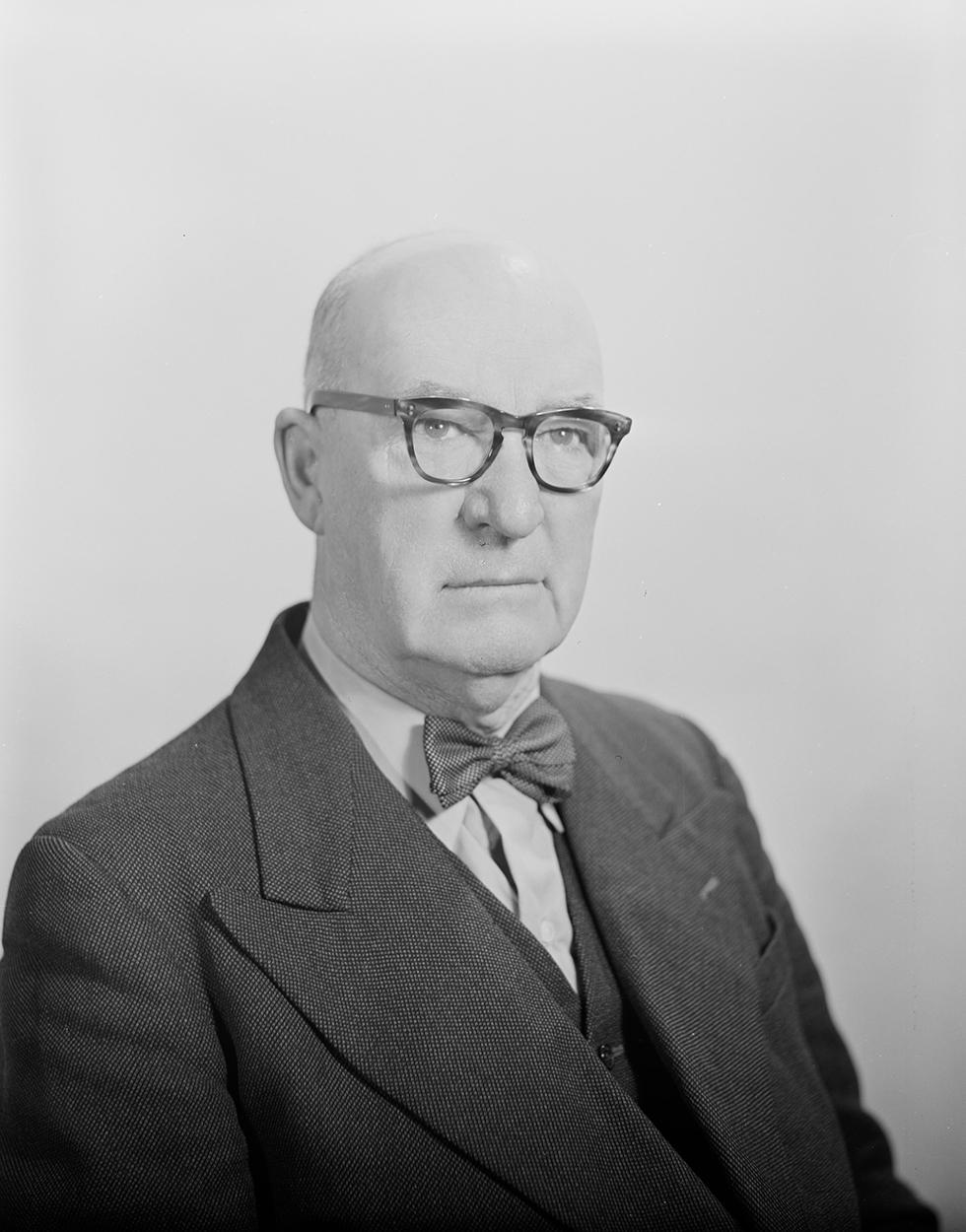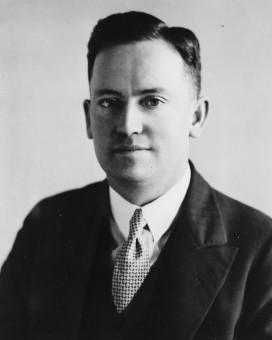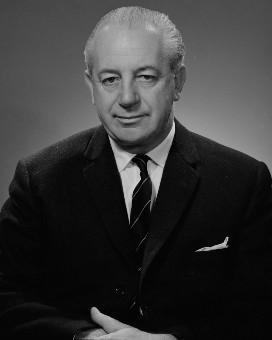Joseph Benedict (Ben) Chifley became Prime Minister on 13 July 1945. The war in the Pacific ended 4 weeks later and Chifley was able to lead a government with the goal of building the peace. Chifley called for Australians to ‘join together in the march of our nation to future greatness’. He told Labor supporters he would provide ‘sane and progressive Government’. For the next 4 years, the Chifley government pursued both the goal and the promise.

Prime Minister Ben Chifley launching the first mass-produced Australian car at the General Motors Holden factory at Fishermen’s Bend, Melbourne, in 1948. NAA: A1200, L84254
Chifley’s economic abilities and his capable advisers formed the right team for a growing postwar economy. The focus of the Chifley government was on a strongly centralist management of the national economy. The government introduced major national projects such as the Snowy Mountains hydro-electric scheme.
In international affairs, Chifley supported the independence of India and Indonesia, seeing these countries as a bulwark against Communism. The emergence of the Cold War and of the Liberal Party as a new anti-Labor force under the leadership of Robert Menzies toppled Chifley’s government in 1949.
Cabinet 1945 and 1946
Chifley’s first ministry was largely the Curtin ministry, as led by Frank Forde for eight days. Curtin’s Defence portfolio was first held by Jack Beasley, with Senator William Ashley taking Beasley’s Supply and Shipping portfolio. When Beasley resigned on 15 August to become Australia’s High Commissioner in London, Frank Forde took Defence. Immigration was allocated to Arthur Calwell, the first to hold this new portfolio.
When Caucus met to elect a new ministry after the election win in September 1946, 2 former ministers were no longer in parliament. Frank Forde had lost the Capricornia seat and Norman Makin had become Australia’s Ambassador in Washington. Forde’s Defence portfolio was given to Jack Dedman, his Army portfolio to Cyril Chambers.
In the ministry sworn in on 1 November 1946, Makin’s successor in the Navy portfolio was newcomer William Riordan, and in Munitions, Senator John Armstrong. 4 other new ministers were Herbert Barnard (Repatriation), Senator Benjamin Courtice (Trade and Customs), Nelson Lemmon (Works and Housing) and Reg Pollard (Commerce and Agriculture).

Senator WP Ashley, Minister for Supply and Shipping in the Chifley government. NAA: A1200, L21690
Immigration and employment
When the 18th parliament was opened on 6 November 1946, about a quarter of a million defence personnel had not yet been repatriated. At Christmas 1946, Chifley made the dramatic gesture of flying to join them. In typical Chifley fashion, this was unannounced and his aircraft landed unexpectedly in Port Moresby. There Chifley joined the troops for meals in their mess tents. After visiting the Australian bases in New Guinea, he flew to Bougainville where his aircraft nearly crashed in a tropical storm. At Bougainville, airmen who were disgruntled at the long delay in their return to Australia, sabotaged the aircraft while Chifley was meeting the troops.
But such incidents were few and the process of demobilisation went relatively smoothly. The postwar demand for labour was much greater than expected, particularly in housing, as industries switched from wartime to civilian production. Although about 10,000 service personnel were released from the forces each week, unemployment did not climb above 0.5%. The seemingly unquenchable demand for labour allowed the government to press ahead with an assisted immigration scheme. It was intended to bring out mainly British migrants to augment the Australian population and make the country more secure from any future threat.
International affairs
Chifley was loath to involve Australia in wars to suppress the national aspirations of countries in Asia. One of those nations was Indonesia, whose independence struggle Chifley did much to support through his promotion of the principle of self-determination. Chifley was also concerned that the Netherlands East Indies should not be broken up into a number of small island states subject to instability. The strategic importance of the islands to Australia’s north had been demonstrated after 1941. Chifley wanted the new nation of Indonesia to act as a barrier to the southward expansion of any Asian power potentially hostile to Australia. The possibility of newly independent India having a Communist government was seen as one means by which Communism could spread through the Indonesian archipelago towards Australia.
Chifley’s vision for achieving what he called a ‘golden age’ depended on expanding world trade and opening up new markets for Australian exports. Markets for both primary produce and the output of the many factories established during the recent war were equally important. To achieve this expansion in trade required the pre-war tariff barriers to be broken down across the globe. Chifley supported the creation of international organisations to manage a global economy and prevent a return to depression conditions.
Chifley was adamant that Australia must ratify the agreement setting up an international monetary system. The ‘Bretton Woods agreement’ had been reached in 1944, at a meeting of 45 nations in New Hampshire in the United States. Opposition within the Labor Caucus meant ratification was delayed until early 1946, when Chifley confronted opponents within the party. It took a year of argument with Cabinet, then with the party’s federal executive, and finally with Caucus before Chifley was authorised to present the enabling legislation to parliament. This determined achievement signified Chifley’s commitment to making Australia a prosperous country linked by trade to the newly independent nations of the region.
Chifley did what he could to hamper the Netherlanders in their attempts to re-impose colonial rule by force. He also refused to send forces to help the British suppress the developing insurgency in their colony of Malaya. Rather than trying to suppress such rebellions, Chifley argued that it was preferable to address the underlying conditions that gave rise to them. But the success of Communism in China prompted anxiety in many Australians. The Catholic Weekly warned its readers in November 1948 that it would ‘only be a matter of time before Australia faces invasion by millions of Communist-driven slaves’. Such predictions were accepted by many Australians, including some members of the Labor Party. The Catholic Movement was intent on driving Communists out of trade unions. Chifley had a difficult time resisting their calls for the government to ban the Communist Party.
The pressure on Chifley increased when the Communist-dominated Miners Federation went on strike to achieve better conditions for its members. Reform was slow in this industry where poor and dangerous working conditions were an everyday experience. Housing and other living conditions in mining towns had been slow to improve after the war. Initially, Chifley dismissed allegations that the trouble was part of a Communist-directed plan to discredit, or even topple his government. However, reports of similar industrial disputes in Britain, France and Italy, seem to have concerned him the disputes in Australia might be part of a wider threat.
The economy and the banks
As Prime Minister and Treasurer, Chifley was at the head of an army of young technocrats he had encouraged into the public service. Their formula for keeping inflation in check was a continuation of wartime price and import controls, plus rationing of scarce commodities. The system was policed by inspectors and administered by ration books. These controls were increasingly resented by businesses and consumers once the war was over. There was also widespread frustration at shortages caused by the postwar strikes workers undertook to improve their wages and conditions in the booming economy.
Liberal Party leader Robert Menzies hoped this resentment would deliver him victory at the election in September 1946. Chifley refused to get in a bidding war with Menzies to buy votes, declining to match a promise by Menzies to cut income tax by 20%. At meetings repeated around the country, Chifley set out for his audiences what he described as ‘a plain, true, commonsense picture’ of what Labor had achieved. He also created a vision for the future, a new ‘golden age’ of peace and shared prosperity.
With Labor comfortably returned to government, the vision was seen to depend on the government gaining power over the supply of money and credit – something the private banks were determined to resist. Despite the ruling that Labor’s 1945 banking legislation was invalid, in mid-1947 Chifley tried to require all local authorities and State governments to bank with the Commonwealth Bank. The Melbourne City Council appealed to the High Court, which ruled against the government in August that year. Since the banking Royal Commission in 1935, Chifley had been determined that the federal government should have this control. Without it, Chifley feared that government could not hold the reins of inflation.
On the weekend following the Court’s decision, Chifley called his Cabinet together to propose the nationalisation of the banks. With the support of all his colleagues, Chifley issued a one-sentence press statement announcing this move, ‘with proper protection for the shareholders, depositors, borrowers and staffs’. His press secretary, Don Rodgers, claimed that Chifley was triumphant in making a move that fulfilled ‘a dream that he’d held for so many years’. Many in the labour movement greeted the news with a mixture of shock and delight. But it caused uniform outrage among the more conservative members of the community, unleashing a massive and well-funded campaign by the private banks. Within days, Menzies had organised a public meeting in the Sydney Town Hall. There he likened the move to ‘Fascism’, claiming that it was part of ‘the Chifley pattern’ of ‘coming dictatorship in Australia’.
In October 1947, Chifley introduced his banking legislation to parliament, arguing the control of money and credit was too important to be left in the hands of private banks. Government, he said, would be able to guard against both depression and inflation, and:
open a long-locked doorway to the development of a monetary and banking system truly adequate to our national requirements and wholly devoted to the service of Australia.
There was a strong reaction from the Opposition benches. Menzies claimed this opened up ‘a second battle for Australia’. Country Party leader Earle Page called it a ‘communist ramp’ and warned that his supporters might use ‘physical means’ to oppose it.
Just how unpopular the proposal was became evident when Chifley lost his position on the Abercrombie Shire Council. It was also blamed for the Victorian Labor government being voted out of power that year. Chifley was unmoved by the reaction, arguing Labor was ‘a party of reform’ and ‘must fight for what it believes to be right, whether that brings electoral success or not’.
Chifley anticipated the High Court would declare this latest banking act invalid once it was challenged. HV (Bert) Evatt advised the Prime Minister that an appeal to the Privy Council in England would reverse the Court’s decision. As predicted, the High Court declared the law invalid, but the Privy Council then upheld the ruling. Chifley stubbornly refused to have the law removed from the statute books, leaving it to simmer and become a potent source of anti-Labor sentiment in the 1949 election.

'Doc' Evatt, Attorney-General and Minister for External Affairs, 1941 to 1949. NAA: A1200, L10375
The Cold War
The increasing polarisation of the world between east and west challenged Labor’s vision for a postwar world of cooperation between the United States and the Soviet Union.
With Communism gaining strength in Europe and in Asia, the government’s attempt to nationalise the banks evoked Opposition claims that Chifley wanted to socialise the country by stealth. Centralism had become widely suspect. Chifley’s centralism was constrained by the Constitution’s definition of the boundaries of federal powers, and his attempts to extend those boundaries by referendum met limited success. The only proposal supported by voters was a constitutional amendment in 1946 enabling the Commonwealth to take responsibility for social services.
The referendum in May 1948, seeking a constitutional change allowing wartime powers to control rents and prices to continue, was decisively rejected. With inflation already showing signs of getting out of control, Chifley’s economic adviser HC (Nugget) Coombs advised the outlook was ‘more or less unpleasant’. The proposed controls would have provided a regulatory lid on inflation.
In March 1949, the government charged Communist Party leader Lance Sharkey with sedition under the Crimes Act. Sharkey had suggested that Australian workers would welcome Soviet soldiers to Australia. When the coal miners went out on strike 3 months later, Chifley immediately took a tough stance. Union funds were frozen, and it was illegal to donate money to strike funds. 8 of the union leaders were sent to jail, and when the strike entered its second month, troops were sent in to work the mines. This forced the miners back to work, but not before considerable hardship and unemployment had been caused in Australian towns and cities starved of coal.
1949 election
Chifley was given the freedom of Bathurst in a ceremony in his home town in the wake of the coal strike, but this was not a sign of wider approval at the start of an election year. The 8 years of Labor government had produced much to be proud of, and Chifley trusted the people to judge his government on its achievements since 1945. In 1946, voters had shared his view, allowing Labor to hold most of the gains Curtin had achieved at the previous election, while gaining nearly all the Senate seats too. In 1946, Menzies had warned darkly that Labor’s dominant position in the parliament would mean ‘undisputed Socialist rule’.
Chifley prepared for the election by announcing an array of nation-building ventures. These included the massive Snowy Mountains scheme to bring irrigation water to the interior and hydro-electricity to the cities, and the establishment of a national university in Canberra with a strong focus on scientific research. He told the annual conference of the New South Wales Labor Party in June that the labour movement had ‘a great objective – the light on the hill – which we aim to reach by working for the betterment of mankind...’ Labor would ‘bring something better to the people, better standards of living, greater happiness to the mass of the people’.
Chifley did not help Labor’s chances at the coming election by insisting that petrol rationing had to remain in place, nor by keeping the issue of bank nationalisation alive. Nevertheless, Chifley and many of his colleagues could not believe that the Australian people would vote for Menzies, the discredited war leader of 1941. At a Canberra dinner before Labor parliamentarians dispersed to begin campaigning in their electorates, Chifley assured them that they could go content that the government had done everything that was possible to do over the last 3 years.
As at the 1946 election, in 1949 Chifley wanted to be judged on his record. His was a government that had been about bringing full employment, instigating great development projects and immigration schemes, extending social welfare provisions to the less fortunate, and successfully managing the transition from war. But the Opposition said in reply that it was also about petrol rationing, bank nationalisation, government regulation and Communism. Menzies offered a shopping list of promises – the lifting of petrol rationing was one of the most prominent. Chifley simply offered more of the same.
Chifley might have managed to win had his old nemesis, Jack Lang, not made a last-minute speech in Sydney that publicised Chifley’s financial operations in the 1930s. As a private lender, Chifley had offered loans and mortgages at relatively high rates of interest, at a time when he was publicly blasting the banks over their interest rates. Splashed across newspaper front pages, the stories seemed to demolish the popular image of Chifley living an austere and frugal life in a simple Bathurst cottage.
The revelation that Chifley had been a successful financial advisor and manager for 20 years was most damaging because it was true. Trusted as someone who knew about money, Chifley had managed financial trusts for friends, lending prudently on mortgages to people who could not get bank loans, and reaping a sound return. He had also managed the substantial property and money Elizabeth Chifley had inherited from her parents. This had never been public knowledge, and it exploded with considerable negative effect on Australian opinion of the legendary would-be bank nationaliser. It is difficult to assess the electoral damage these charges caused. Chifley thought that people made up their minds months before an election, and were little influenced by the campaign.
Whether he was right or not, voters showed clearly they wanted a change of government. Though Labor won 47 seats in the newly expanded House of Representatives, Menzies’ Liberal Party won 55 seats and took government outright.
Sources
- Day, David, Chifley, Harper Collins, Sydney, 2001.
- McMullin, Ross, ‘Joseph Benedict Chifley’, in Michelle Grattan (ed.), Australian Prime Ministers, New Holland Press, Sydney, 2000.
- Rowse, Tim, Nugget Coombs: A Reforming Life, Cambridge University Press, Melbourne, 2002.
From the National Archives of Australia collection
- Banking Act 1945, City of Melbourne v Commonwealth of Australia, NAA: A432, 1947/625
- Opening ceremony of the Snowy Mountains Hydro-electric Scheme, Adaminaby, October 1949, NAA: A11016, 821





